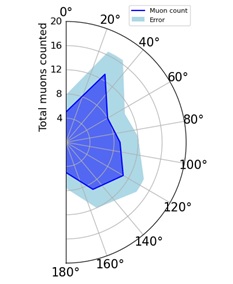Exploring the Sensitivity of MiniPix Devices to the Detection of a Variety of Particles
DOI:
https://doi.org/10.59973/emjsr.26Keywords:
cosmic ray muons, radiation, particle detector, MiniPix EDU detector, ADVACAMAbstract
The MiniPix EDU devices by ADVACAM have been used to study electrons, muons and alpha particles from both thoriated tungsten rods and natural sources. The natural radiation experiments looked at muons, focusing on the determination of muon count as a function of detector altitude and inclination with respect to the horizon. This included taking readings at ground level compared to those atop a building, and the floors in between, and rotating the detector face a certain angle to find the optimal angle to detect muons. The experiments involving a radiation source looked at alpha and beta decay. This included using the detector’s measurement of kinetic energy to explore the relativistic nature of electrons produced via beta decay, and the decay characteristics of alpha radiation. The material attenuation of alpha particles has also been explored. Insights from these experiments provide data on the capabilities of the detector. Through these experiments, particle behaviour and interactions unfold, shedding light on fundamental scientific principles. The project's experiments and results have been simplified to cater to secondary school education, specifically GCSE-level students. The experiments are designed to be performed within a school setting, helping students to understand these fundamental scientific principles of physics.
References
ADVACAM MiniPIX EDU, Portable USB Camera for Education, Accessed 16/08/23,
https://advacam.com/camera/minipix-edu
S. Jackson NASA, CERN Timepix Technology Advances Miniaturised Radiation Detection, Oct 4, (2019), accessed 16/08/23
https://www.nasa.gov/feature/nasa-cern-timepix-technology-advances-miniaturized-radiation-detection
The Centre for Public Engagement, About Public engagement, Public Engagement, Queen Mary University of London, accessed 22/08/23, https://www.qmul.ac.uk/publicengagement/about-engagement/centre-for-public-engagement/
Archer, Martin O. "Schools of all backgrounds can do physics research–on the accessibility and equity of the Physics Research in School Environments (PRiSE) approach to independent research projects." Geoscience Communication 4, no. 2 (2021): 189-208. Accessed 22/08/23 https://gc.copernicus.org/articles/4/189/2021/ DOI: https://doi.org/10.5194/gc-4-189-2021
Outreach Team, “MINIPIX EDU Students’ Manual” draft, Particle Physics Research Centre, Queen mary University of London, Page 7 “Working Principles’, accessed 17/8/13
User:SyntaxError55, “File:Atmospheric Collision.svg”, WIKIPEDIA Commons 27/10/2007, Accessed 1/8/2023,https://commons.wikimedia.org/wiki/File:Atmospheric_Collision.svg
Llopart X 2007 Design and characterization of 64K pixels chips working in single photon processing mode PhD Thesis(Accessed 22/8/23), http://cds.cern.ch/record/1056683?ln=ca
Llopart X, Ballabriga R, Campbell M, Tlustos L and Wong W 2007 Timepix, a 65k programmable pixel readout chip for arrival time, energy and/or photon counting measurements Nucl. Instrum. Methods Phys. Res. A 581 485–94 , accessed 22/8/23, https://www.sciencedirect.com/science/article/pii/S0168900207017020?pes=vor DOI: https://doi.org/10.1016/j.nima.2007.08.079
Campbell M 2001 Electronics for pixel detectors 7th Workshop on Electronics for LHC Experiments (CERN Document Server) 11–16, https://iopscience.iop.org/article/10.1088/1361-6552/ac4143/meta
J. Bramante, “Dark matter, detection, an overview of overburdens”, Queen’s UNiversity, The McDonald Canadian Astroparticle Physics Research Institute, Perimeter Institute, accessed 16/8/23, https://indico.cern.ch/event/1027519/contributions/4325877/attachments/2244424/3806019/DM%20Detection%20Overburdens.pdf
B. Armbruster, I. M. Blair, B. A. Bodmann, N. E. Booth, G. Drexlin, J. A. Edgington, C. Eichner et al. "Upper limits for neutrino oscillations ν¯ μ→ ν¯ e from muon decay at rest." Physical Review D 65, no. 11, 1-16 (2002) DOI: https://doi.org/10.1103/PhysRevD.65.112001
K. Dreessen, Seeing the Invisible, GENESOSCENE, Nov 16, pp. 1 (2020), accessed 14/08/23,
https://scene.geneseo.edu/2020/11/seeing-the-invisible/
M. Bektasoglu, H. Arslan, “Investigation of the zenith angle dependence of cosmic-ray muons at sea level”, Pramana Journal of physics, c Indian Aademy of Sciences , Vol. 80, No. 5,( May 2013), Page 843, accessed 16/8/23, https://www.ias.ac.in/public/Volumes/pram/080/05/0837-0846.pdf DOI: https://doi.org/10.1007/s12043-013-0519-2
Olley, Jon M., Andrew Murray, and Richard G. Roberts. "The effects of disequilibria in the uranium and thorium decay chains on burial dose rates in fluvial sediments." Quaternary Science Reviews 15, no. 7 (1996): 751-760 DOI: https://doi.org/10.1016/0277-3791(96)00026-1
R. Ballabriga, A. Le Gall, 29 March, 2021,“TimePix-based detectors bring particle physics in the classroom”, CERN knowledge transfer, Accessed 16/8/23 https://kt.cern/news/news/knowledge-sharing/timepix-based-detectors-bring-particle-physics-classroom
G. Feinberg,(February 1970), “Particles That Go Faster Than Light”, Scientific American Vol 222, No.2, page 69, accessed 16/8/23 DOI: https://doi.org/10.1038/scientificamerican0270-68
P. P. Urone, R. Hinrichs, (2023), Special Relativity, LibreTexts Physics, Ch 13, 571-588, accessed 14/08/23
N.s Voudoukis,S. Oikonomidis, (November 2017), ”Inverse Square Law for Light and Radiation: A Unifying Educational Approach”, EJERS, European Journal of Engineering Research and Science Vol.2, No.11,,Page 23, I. Introduction, accessed 16/8/23 DOI: https://doi.org/10.24018/ejers.2017.2.11.517
https://ej-eng.org/index.php/ejeng/article/view/517/212
arpansa, “Alpha Particles”, “What are the properties of alpha particles?”, Australian government, Australian radiation Protection And Nuclear Safety Agency, accessed 16/8/23 https://www.arpansa.gov.au/understanding-radiation/what-is-radiation/ionising-radiation/alpha-particles

Downloads
Published
How to Cite
Issue
Section
License
Copyright (c) 2023 Megan Rose Lawie, Freddie Vosper, Dr. Linda Cremonesi, Dr. Alex Booth

This work is licensed under a Creative Commons Attribution 4.0 International License.














